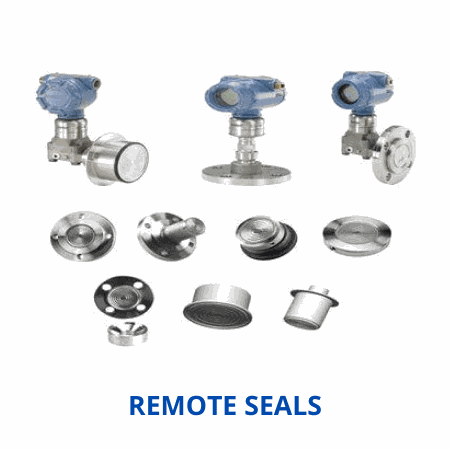Blog
Remote Seals: Significance, Working Principle & Applications
Remote Seals: Significance, Working Principle & Applications
June 08, 2020
Remote seals are flexible membranes that are used in pressure equipment to protect them from damaging media. These seals are often used in devices such as pressure sensors, pressure transmitters, pressure switches, and so on. Remote seals are also known as chemical seals or diaphragm seals. How do these seals work? What are its advantages? This post introduces you to remote seals and then focuses on their industrial significance, applications, and more.
The remote seals are elastic membranes that seal and isolate the pressure-sensitive devices from any media that may impact its function. These seals are often made of durable and chemical resistant materials like steel, TEFLON, and non-metals. These seals help in resisting the flow of fluid trapped inside pressure equipment without causing any pressure rise. These diaphragm seals help protect the pressure equipment from corrosion, chemical reactions, and unwanted fluid leakage. A remote seal can be mounted in multiple ways such as flanged, threaded, inline mounting, and so on, on the pressure measurement device.
Performance Capabilities of Different Types of Diaphragm Seals
Depending on the material of manufacturing and type of mounting, these seals can offer varying performance. The performance capabilities/parameters of remote seals are as follows.

Metal Seals:
Stainless steel is the most common material for making remote seals, however, carbon steel and Hastelloy® C-276 is also used. The metal seals can handle pressures from 2500 psi to 5000 psi if thread mounted.
Teflon Seals:
The Teflon seals can handle up to 1500 psi pressure. Being an FDA approved material, Teflon seals are also used in sanitary applications.
Elastomer/Non-metal Seals:
These elastomer seals can perform up to 100psi. They can be made of different materials.
The above-mentioned performance capabilities are mentioned for temperature 100° F (38° C). The pressure being directly proportional to temperature, as the temperature varies, pressure values in the application would vary accordingly.
How Do Remote Seals Work?
The diaphragm seals are connected to pressure equipment by direct capillary action. These seals act as an intermediate between the pressure equipment and the pressure media. The barrel or chamber encapsulates a fluid that transmits pressure from the pressure media to the diaphragm. Every time the pressure fluctuation from pressure media is experienced, the difference in pressure is exerted on the diaphragm. The pressure change on the diaphragm is then hydraulically transmitted to the pressure device or a sensor in order to record the reading. However, in some cases, the seals exert reverse pressure on the media. This pressure is equal to the amount of pressure transmitted from the pressure media. The reverse pressure exerted by the diaphragm seal is then considered as the reading by a pressure sensor or measuring equipment.
What is the Industrial Significance of Remote Seals?
The remote seals are of great importance in the pressure equipment. They are significant in certain situations, mentioned below.
- The fluid inside the pressure equipment like pressure transmitters can be corrosive, chemically reactive, or sometimes hazardous to use in certain environmental conditions. The fluid can be liquid or gas, and if it escapes the chamber, it can damage the equipment in many ways. Pressurized gases can cause accidents, and liquids can cause chemical reactions and defects like surface rupture and corrosion. In such cases, it is very important to keep the fluids trapped inside the equipment.
- The fluids that consist of slurry, sludge, or are vicious in nature can cause serious damage to the pressure measuring equipment. These fluids can coat the equipment surface which can impact the performance. If the viscous fluids enter cavities of the pressure equipment, then the chances of repair and component replacement reduce. In such cases, good quality diaphragm seals are of significant use.
What Are the Industrial Applications of Remote Seals?
Remote seals are used in various industries. For instance, they are used in:
There are different types of diaphragm seals from different brands available in the market. Of these, Rosemount remote seals have gained immense popularity across industries owing to several benefits that they offer. Having said that, ensure that you source these seals only from trusted suppliers like The Transmitter Shop (TTS). The company provides new, surplus, and reconditioned remote seals and pressure transmitters from several industry-leading brands. Rosemount remote seals are one of the most popular products in their inventory.
- Chemical industries as pressure chemical injectors
- Food and beverage industries in pressure sensors
- Hydrocarbon processing plants
- Pharmaceutical industries where pressure metering devices are implemented
There are different types of diaphragm seals from different brands available in the market. Of these, Rosemount's remote seals have gained immense popularity across industries owing to several benefits that they offer. Having said that, ensure that you source these seals only from trusted suppliers like The Transmitter Shop (TTS). The company provides new, surplus, and reconditioned remote seals and pressure transmitters from several industry-leading brands. Rosemount remote seals are one of the most popular products in their inventory.
- Comparison between Multi Valve Manifolds Block Valves and Bleed Valves
- Understanding Electrochemical Detection: Principles, Techniques and Environmental Application
- How Can Greenhouse Gas Emissions Be Reduced?
- Pneumatic Pressure Controllers: A Safe Choice for Hazardous Areas
- A Practical Guide to Vacuum Measurement and Operation
- Understanding Electrochemical Detection: Principles, Techniques and Environmental Application
- How Can Greenhouse Gas Emissions Be Reduced?
- Pneumatic Pressure Controllers: A Safe Choice for Hazardous Areas
- A Practical Guide to Vacuum Measurement and Operation
- An Unconventional Guide to Selecting the Right Pressure Sensor
QUICK ENQUIRY